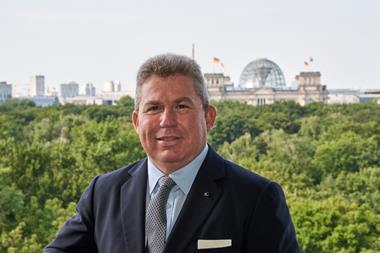The IPE Real Estate Global Conference & Awards has long had an intentionally global focus – albeit with a strong European bias (it is always held in European cities). That international remit was confirmed on Thursday evening when National Pension Service of South Korea won the top accolade of Global Real Estate Investor of the Year.
But in a new era of heightened geopolitical tensions, US trade tariffs and potential deglobalisation, that domestic bias came to the fore. This year’s conference in Copenhagen routinely turned its attention to the role of Europe in the world today, including its capacity to act as a region of political unity and economic power and attract global capital flows.
Just before the conference started, US government bond markets fell, seemingly in response to US President Donald Trump’s “big, beautiful” tax bill. The US dollar had already been weakening against other currencies, including the euro, and during the pre-conference investor-only roundtable conversations turned to whether Europe could play the role of an alternative safe haven and begin to attract more global investment.
Opening the main day, international trade policy adviser Hanna Norberg – who had crossed the Øresund Bridge from nearby Malmö to join the conference – was clear on the significance of Trump’s trade policies. Tariffs always hurt the country that implements them the most, she said, and “these tariffs will have visible effects on the US economy”. Furthermore, investment that would otherwise have gone to the US is now being redirected to other regions like Europe, she added.
There was some evidence that this could become the case among institutional real estate investors. A live poll that morning revealed that more than three-quarters of the audience would prefer to reduce their target allocation to the US and increase it to Europe. The significance was not lost on those in the room and was clearly a key take-away from the event.

“This image speaks for itself,” wrote Simon Martin, chief investment strategist and head of research at Tristan Capital Partners, posting a photo of the chart in his weekly email bulletin to investors.
“Stunning survey from today’s IPE conference in Copenhagen”, wrote Simon Wallace, global head of real estate research at DWS on LinkedIn. “OK, there are geographic and other biases in the room, but this is a survey of some of the world’s leading real estate investors and managers. The shift in sentiment towards Europe is a trend we should be watching very closely. This sort of live survey data is a fascinating way to gauge sentiment in today’s market.”
“I think the prevailing sentiment is pretty strong in terms of a relative value for Europe versus America. I tend to buy that,” said Randy Giraldo, head of Europe at Nuveen Real Estate, at the end of the conference, in a recap of the day with conference chair Piet Eicholtz.
However, he also raised the possibility of contrarian opportunities coming from the US if investors are overly bearish on the country. “I actually can’t help but think about the opposite side of the trade, though, in that [there] could be a buying opportunity there as well.” Giraldo, an American in Europe, who until 2023 had been managing the TIAA Real Estate Account in New York, was arguably well placed to make comparative transatlantic assessments. “But generally I would say Europe’s in a relatively good position,” he added. “It hasn’t been for a long time in terms of cross border flows – especially from the US.”
Institutional investors from the US have typically required higher rates of return for taking on the risks of investing outside their large and liquid domestic market, but there were signs that return expectations on both sides of the Atlantic were reaching “relative parity”, Giraldo said. “And the need for diversification now seems more important than ever before. It was kind of academic; now it seems a lot more tangible.”
Despite all the talk of Europe being a beneficiary of perceptions of US instability, Eichholtz, real estate professor at Maastricht University, admitted that he was “really worried, because the world really needs a safe haven”. He said: “You need that like an anchor. It would be really bad if that anchor blows away and I don’t think Europe and the euro area is ready to take on that role.”
Back to the office or into an urban doom loop?
Whether US capital – or domestic, for that matter – will find its way into the office sector, is another question. The US office market has suffered markedly from the structural decline in demand for space since COVID-19 and more so than its counterparts in Europe and Asia. But investors seem fairly split on wisdom of re-entering the space after the recent reset in values across markets.
An audience poll showed that those in the room intending to invest in offices in the next 12 months were outnumbered by nearly two to one by those taking a more bearish view of the sector. Even two of the large ‘Maple 8’ Canadian pension fund investors revealed divergent perspectives.
Oxford Properties, the real estate arm of OMERS, which has a history of investing in office buildings, is back in the market after being notably absent from the sector in recent years, according to head of European asset management Jay Drexler. Meanwhile, QuadReal, the property group of British Columbia Investment Management Corporation, is “bearish” on offices and not looking to invest, said Peter Kim, global head of strategic partners.
Arpit Gupta, assistant professor of finance at NYU Stern School of Business, was a co-author of a 2022 white paper, ‘Work from home and the office real estate apocalypse’, which argued how the post-COVID structural decline in demand for space and the reduction in value of offices had implications for the public finances of cities like New York. The reduction in revenue for cities was prompting local authorities to raise taxes further, leading to more people leaving and risk what the authors terms an “urban doom loop”.
Speaking on the panel in Copenhagen, Gupta was still bearish on the office sector, despite occupancy of office markets in cities like New York improving over the past couple of years. He argued that the ongoing effects of remote working would have a “persistent effect” comparable to the effect of online shopping on retail property.
Take AI for a walk
When asked by John O’Driscoll, global co-head of real estate at AXA IM Alts and moderator of the panel, how office would perform relative to other real estate sectors, Gupta added that the rise of artificial intelligence (AI) and its potential to “replace white-collar jobs” would only exacerbate the situation.
However, during the following session, Nikodem Szumilo, director at The Bartlett Real Estate Institute, pointed out that while many high-profile corporates had replaced jobs with AI, they were also tending to hire more people to work with AI. In fact, the combination of people and AI leads to the technology at its most powerful, he said, a lesson that the real estate investment industry needs to fully accept.
His take-away advice for everyone in the room was to go on an “AI brainstorming walk” and to talk through the hardest challenges they were facing at the moment.
Giraldo and Eichholtz agreed that Szumilo’s was probably the most memorable session of the day. “I think everyone’s going to point to Niko’s AI piece,” said Giraldo. “I thought that was really interesting. I’m going to try an AI walk.”
To read the latest IPE Real Assets magazine click here.
























